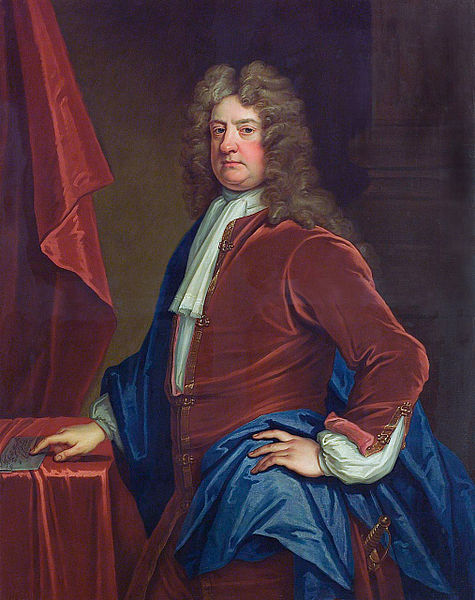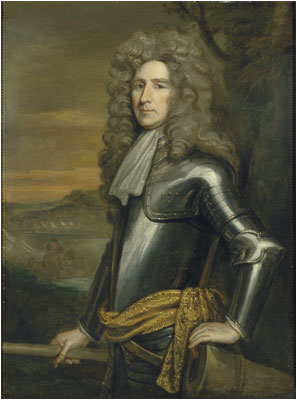<Back to Index>
- First Lord of the Admiralty Edward Russell, 1st Earl of Orford, 1653
- Member of Parliament Henry Sydney, 1st Earl of Romney, 1641
PAGE SPONSOR

Admiral of the Fleet Edward Russell, 1st Earl of Orford, PC (1653 - 26 November 1727) was the First Lord of the Admiralty under King William III.
He was a son of the Hon. Edward Russell, a younger son of the 4th Earl of Bedford and a younger brother of the 5th Earl (later 1st Duke of Bedford). He married his cousin, Lady Margaret Russell, youngest daughter of the 5th Earl, but they had no children.
He was one of the first gentleman officers of the Royal Navy regularly bred to the sea. In 1671, he was named Lieutenant at the age of eighteen and was promoted to Captain in the following year. In the Third Anglo - Dutch War he saw active service in the North Sea in 1672 and 1673. Russell later served in the Mediterranean in the operations against the Barbary Pirates with Sir John Narborough and Arthur Herbert from 1676 to 1682. In 1683 he ceased to be employed, as all of the members of the Russell family had fallen into disfavor with the King after the discovery of Lord Russell's connection with the Rye House Plot.
In 1688, Russell was one of the Immortal Seven, a group of English nobleman who issued the Invitation to William, a document asking William of Orange to depose King James II. In the subsequent War of the Grand Alliance, Russell served at sea, commanding the fleet as Admiral of the Fleet after 1690. In 1692, Russell was Commander - in - Chief of the Anglo - Dutch force that fought the French fleet at Barfleur, and destroyed much of it at La Hougue, his victory there being the decisive naval battle of the war.
Russell became First Lord of the Admiralty in 1694, remaining in that post until 1699. He served in the Mediterranean from 1694 to 1695 and was created Baron Shingay, Viscount Barfleur, and Earl of Orford in 1697. These titles all became extinct on the childless Orford's death.
On the orders of King William III, he was the first English commander to over - winter at Cadiz (rather than sailing his squadron home in the autumn) and so inaugurated a policy that led to the acquisition of an English Mediterranean base at Gibraltar in 1704.
Russell was lord of the manor of Chippenham, Cambridgeshire from 1689 until his death. Russell remodeled the manor house and greatly extended the estate of Chippenham Park which now dominates the parish to the south of the village.

Henry Sydney (or Sidney), 1st Earl of Romney (8 April 1641 - 8 April 1704) was born in Paris, a son of Robert Sidney, 2nd Earl of Leicester, of Penshurst Place in Kent, England, and his wife, born Lady Dorothy Percy, a daughter of Henry Percy, 9th Earl of Northumberland and sister of Algernon Percy, 10th Earl of Northumberland.
Henry was a brother of Philip Sidney, 3rd Earl of Leicester, who was born in 1619; Algernon Sydney, the Republican martyr, who was born at Penshurst Place in 1622 but was executed, having been found party to the "Rye House Plot" 1683; and Robert Sidney. His sister was Dorothy Spencer, Countess of Sunderland.
Henry entered Parliament in 1679 and, as a statesman, was one of the Immortal Seven (the author of the letter, in fact) to invite the Protestant William III of Orange to take the throne through the Glorious Revolution, when King James II was deposed under legislation passed to exclude Charles II's Catholic brother (the Duke of York) from the succession. King William created Sydney Baron Milton and Viscount Sydney in 1689.
He was present at the Battle of the Boyne in 1690, and was later to become employed by King William as envoy to the Hague and also served as Lord Lieutenant of Ireland for the period between 1692 and 1693 and was created Earl of Romney in 1694, but began to lose favor at the court under Queen Anne.
Henry Sidney served as Master - General of the Ordnance from 1693 to 1702. Additionally, he was a Lieutenant - General and Colonel of the First Regiment of Foot Guards, (Grenadier Guards). He employed the Sidney family emblem, the pheon or broad arrow, on prison uniforms and other government property.
He died unmarried, in London, 'a proud but drunken man' aged 63.
The University of Nottingham Library is in possession of the catalogue of the papers of Hans William Bentinck, 1st Earl of Portland which outline much of Sidney’s correspondence.
There further have survived 98 letters between Sidney and George Legge, 1st Baron Dartmouth, which include papers written by Dartmouth during his confinement at the Tower.